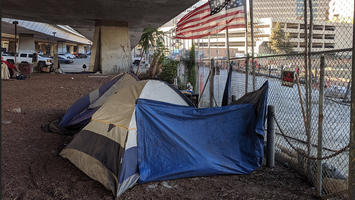
Deep-blue cities and states are eager to declare their social-justice credentials. New York mayor Bill de Blasio has set up a commission designed to uproot the city’s “institutional” racism, while California governor Gavin Newsom brags that his state is “the envy of the world” and will not abandon its poor. “Unlike the Washington plutocracy,” he proclaims, “California isn’t satisfied serving a powerful few on one side of the velvet rope. The California Dream is for all.”
Yet California, though well known for its wealth, also has the nation’s highest poverty rate, adjusted for housing cost. If rhetoric were magic, metropolitan areas like New York, San Francisco, Los Angeles, and Chicago would be ideal places for aspirational minority residents. But according to statistics compiled by demographer Wendell Cox in a newly released report, these cities are far worse for nonwhites in terms of income, housing affordability, and education. New York and California also exhibit some of the highest levels of inequality in the United States, with poor outcomes for blacks and Hispanics, who, population-growth patterns suggest, are increasingly moving away from deep-blue metros to less stridently progressive ones.
The current focus on “systemic racism”—often devolving into symbolic actions like mandatory minority representation on corporate boards, hiring quotas, and an educational focus on racial redress and resentment—is not likely to improve conditions for most minorities. “If a man doesn’t have a job or an income, he has neither life nor liberty nor the possibility for the pursuit of happiness,” Martin Luther King said. “He merely exists.” That remains true. Our lodestar should be upward mobility: improving how well people live, across the board. When it comes to that criterion, blue states and cities are falling short.
The Covid-19 pandemic has inflicted disproportionate harm to the health of Latinos and African-Americans, who, according to the CDC, have suffered rates of infections and deaths higher than the overall population, which makes a focus on upward mobility even more important. To measure progress, we have developed an Upward Mobility Index, with “opportunity ratings” for the nation’s 107 largest metropolitan areas—those with populations of 500,000 or more in 2018—by race and ethnicity. We examined the factors that underpin upward mobility and entry into the middle class. Then, we created a ranking by metro that combined these factors for the three largest ethnic and racial minorities: African-Americans, Latinos, and Asians.
The results confound assertions that nominally progressive policies—affirmative action, programs for racial redress, strict labor and environmental laws—help nonwhites. It turns out that places with low housing costs, friendly business conditions, and reasonable tax rates do much better than cities proclaiming their woke credentials.
African-Americans do best by these measurements in southern metros such as Atlanta, the traditional capital of black America; McAllen, El Paso, and Austin, Texas; and Raleigh, Virginia Beach/ Norfolk, and Richmond, Virginia. The Washington, D.C. metro area, well known for its large, middle-class African-American suburbs, also compares well. Oklahoma City, Phoenix, Lancaster, Pennsylvania, and (perhaps surprisingly) Provo, Utah rank high for black success.
At the bottom of the list, California dominates, with four of the worst ten locations, including Los Angeles, which a half-century ago was widely seen as a mecca of sorts for blacks. Two of the state’s most prominent political leaders of the late twentieth century—four-term Los Angeles mayor Tom Bradley and long-time assembly speaker and San Francisco mayor Willie Brown—came from poor Texas families, not Golden State metros. Other cities traditionally attractive to African-Americans no longer serve as leading places for black ambition, including Miami and New York.
Similar, though somewhat varied, results can be seen for Latinos, now the nation’s largest minority, and Asians, the fastest-growing. Latinos seem to be doing best outside the Northeast Corridor and the West. Fayetteville (Arkansas/Missouri), for example, ranks number 7; it’s an evolving economic hub paced by Walmart, JB Hunt, and Tyson Foods. Latinos have found opportunities in metros tied to basic goods as well as technological production (St. Louis); logistics and agribusiness (Kansas City, Des Moines, and Omaha); energy (Pittsburgh and Oklahoma City); and manufacturing (Grand Rapids and Akron).
In contrast, California, with the nation’s largest Hispanic population, now includes eight of the bottom 15 metros on the Hispanic Upward Mobility Index. The nation’s largest Hispanic conurbation, Los Angeles, ranked 105th out of the 107 largest U.S. metros. The remaining six worst performers, apart from Honolulu, are on the much-deindustrialized east coast, including New York, Bridgeport-Stamford, and Worcester.
Read the rest of this piece at City Journal.
Charles Blain (@cjblain10) is the president of Urban Reform and Urban Reform Institute. A native of New Jersey, he is based in Houston and writes on municipal finance and other urban issues. Joel Kotkin (@joelkotkin) is a contributing editor of City Journal, the Presidential Fellow in Urban Futures at Chapman University, and executive director of the Urban Reform Institute. His latest book is The Coming of Neo-Feudalism: A Warning to the Global Middle Class.
Photo credit: Grendelkhan via Wikimedia under CC 4.0 License.












